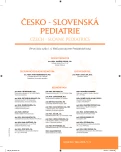Differences in mental health of pupils in urban and rural
Authors:
P. Dankovičová 1; Ž. Fetisovová 1; I. Ondrejka 2
Authors‘ workplace:
Ústav nelekárskych študijných programov, Jesseniova lekárska fakulta UK, Martinprednostka doc. Mgr. M. Bašková, PhD.
1; Psychiatrická klinika, Univerzitná nemocnica, Martinprednosta doc. MUDr. I. Ondrejka, PhD.
2
Published in:
Čes-slov Pediat 2013; 68 (5): 309-318.
Category:
Original Papers
Overview
The aim of the study was to investigate the differences in mental health of pupils in urban and rural. We have not registered a similar study in the domestic and foreign literature sources, however, the several studies suggested that there were differences in the mental health and the prevalance of mental disorders in urban and rural, especially in the adult population. Several authors argue that it is necessary to expand this research which would help to clarify many causalities. We intend to contribute to the expansion of knowledge in this field with our results. The research was carried out at the primary and eight-grade grammar schools in the Žilina region (Slovak Republik). 406 pupils of 6th and 7th class have participated in the research. The average age of pupils was 12.4 years.
The General Health Questionnaire (GHQ12), the Affect Balance Scale (ABS), the Rosenberg Self Esteem Scale (SeS) and the Live Event Inventory (LEI) were used in investigating the extent of mental healh. The Demographic data sheet including age, gender, type of school, year/grade, family type, type of living and education of parents was created as a part of research tools. Mann-Whitney and Chi Square test were applied as a statistical method. A significant difference was found in the Emotional Balance Scale, namely in the Positive Emotions, where the pupils living in urban marked more Positive Emotions in comparison with those living in rural. No significant difference was found in the remaining items.
Key words:
mental health, mental health indicators, primary schools, socio-economic indicator – living
Sources
1. Bradley RH, Corwyn RC. Socioeconomic status and child development. Annu Rev Psychol 2002; 53: 371–399.
2. Socioeconomic Status and Health Fact Sheet – American Psychological Association [online], 2012, [cit. 2011-12-05]. Available from: http://www.apa.org/about/gr/issues/socioeconomic/ses-health.aspx.
3. Waddell Ch. Improving the mental health of young children [online]. Vancouver: Childrens Health Policy Centre, 2007: 1–15, [cit. 2011-06-05]. Available from: http://www.firstcallbc.org/pdfs/Communities/4-alliance.pdf.).
4. Murali V, Oyebode F. Poverty, social inequality and mental health. Advances in Psychiatric Treatment 2004; 10: 216–224.
5. McLoyd VC. Socioeconomic disadvantage and child development. Amer Psychologist 1998; 53: 185–204.
6. Judd KF, Jackson JH, Komiti A, et al. High prevalence disorders in urban and rural communities. Australian and New Zealand Journal of Psychiatry 2002; 36: 104–113.
7. Weich S, Twigg L, Lewis G. Rural/non-rural differences in rates of common mental disorders in Britain Prospective multilevel cohort study. Br J Psychiatry 2006; 188: 51–57.
8. Thompson MJ, Stevenson J, Sonuga-Barke E, et al. Mental health of preschool children and their mothers in a mixed urban/rural population. I. Prevalence and ecological factors. Br J Psychiatry 1996; 168 (1): 16–20.
9. Peen JMS, Dekker J, Schoevers RA, et al. Is the prevalence of psychiatric disorders associated with urbanization? Soc Psychiatry Psychiatr Epidemiol 2007; 42 (12): 984–989.
10. General Health Questionnaire [online], [cit. 2013-19-1]. Available from: http://www.glassessment.co.uk/health_and_psychology/resources/general_health_questionnaire/general_health_questionnaire.asp?css=1.
11. Goldberg D. The General Health Questionnaire 1972. In: Dowell IMc, Newell C. Measuring Health: A Guide To Scales and Questionnaires. New York: Oxford University Press, 1996: 523.
12. Bradburn MN. The Affect Balance Scale 1965. In: Dowell IMc. Measuring Health: A Guide To Rating Scales and Questionnaires. 3rd ed. New York: Oxford University Press, 2006: 748.
13. Rosenberg M. „The Measurement of Self-esteem“ in Society and the Adolescent Self-image. New Yersey: Princeton, 1965: 16–319. (Citované podľa Katreniaková a Kovařová, 2002).
14. Katreniaková Z, Kovářová M. Duševné zdravie v mladšom školskom veku – možnosti a význam jeho zisťovania. Čes-slov Pediat 2002; 57: 589–594.
15. Svoboda M, Krejčířová D, Vágnerová M. Psychodiagnostika dětí a dospívajících. 2. vyd. Praha: Portál, 2009: 792.
16. Katreniaková Z, Kovářová M, Sarková M. Inventár životných udalostí (LEI) – príprava a overenie novej mierky pre detskú populáciu. Čes-slov Pediat 2001; 56 (4): 203–208.
17. Katreniaková Z, Kovářová M, Sarková M. Vplyv pozitívnych a negatívnych životných udalostí na subjektívnu pohodu a sebaúctu v období pubescencie. Čes-slov Pediat 2004; 59: 381–386.
18. Roger DR. Differences found in rates of mental illnesses between rural and urban areas. Mental health and Psychiatry News [online], 2006, [cit. 2011-12-05]. Available from: http://www.health.am/psy/more/differences_found_in_rates_of_mental_illnesses_between_rural_and_urban_area/.
19. The State Of Mental Health In The European Union. [online]. 2004. [cit. 2011-12-05]. Available from: http://ec.europa.eu/health/archive/ph_projects/2001/monitoring/fp_monitoring_2001_frep_06_en.pdf.
20. Shucksmith M, Cameron S, Merridew T. First European Quality of Life Survey: Urban–rural differences. Dublin: European Foundation for the Improvement of Living and Working Conditions, 2006: 79.
21. Kovess-Masféty V, Alonso J, Graaf R, et al. European Approach to Rural–Urban Differences in Mental Health: The ESEMeD 2000 Comparative Study. Can J Psychiatry 2005; 50 (14): 926–936.
22. Paykel ES, Abbott R, Jenkins R, et al. Urban-rural mental health differences in Great Britain: findings from the national morbidity survey. Psychol Med 2000; 30: 269–280.
23. Maggi S, Ostry A, Callaghan K, et al. Rural-urban migration patterns and mental health diagnoses of adolescents and young adults in British Columbia, Canada: a case-control study. J Child Adolesc Psychiatry Ment Health 2010; 4: 13.
24. Mayers DG, Diener E. Who is happy? Psychological Science 1995; 6: 10–19.
Labels
Neonatology Paediatrics General practitioner for children and adolescentsArticle was published in
Czech-Slovak Pediatrics

2013 Issue 5
Most read in this issue
- Alcohol and drug intoxications in adolescents admitted to paediatric centres in the Czech Republic
- Neurocristopathies: The role of neural crest-derived cells in pathogenesis of congenital anomalies in the example of Hirschsprung´s disease
- Clinical context of the thyroid gland development and its disorders in the fetus and newborn (part 2)
- Differences in mental health of pupils in urban and rural
